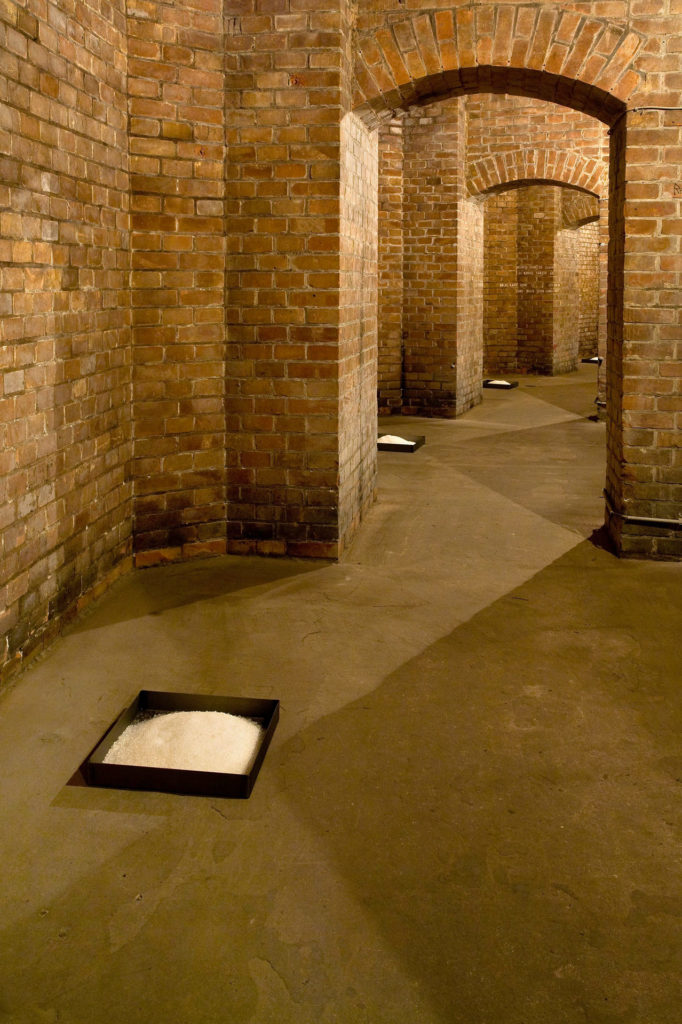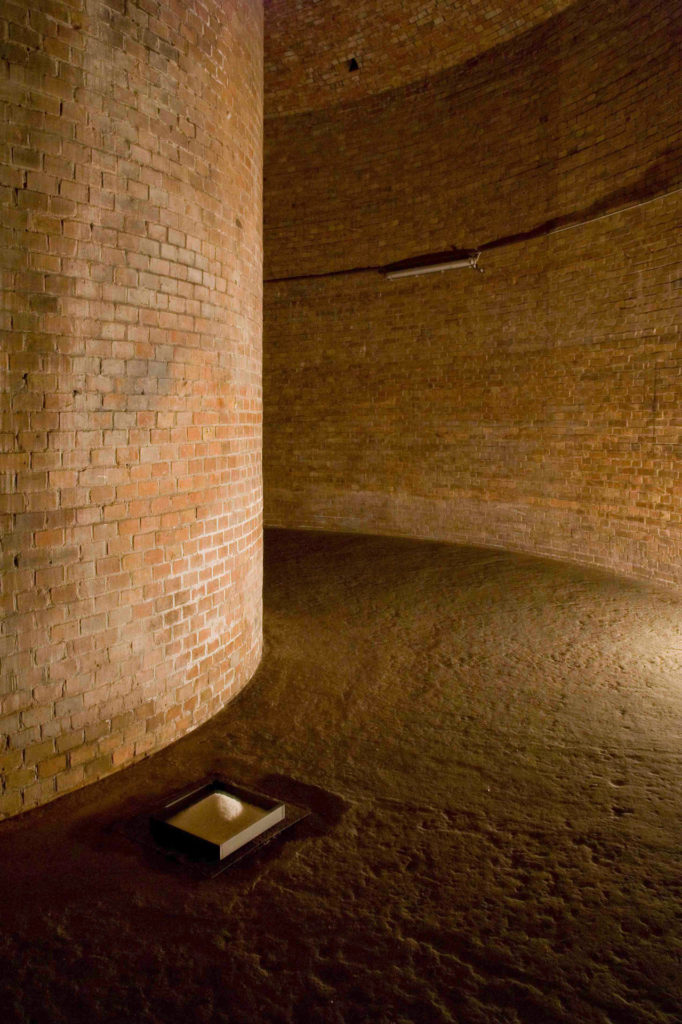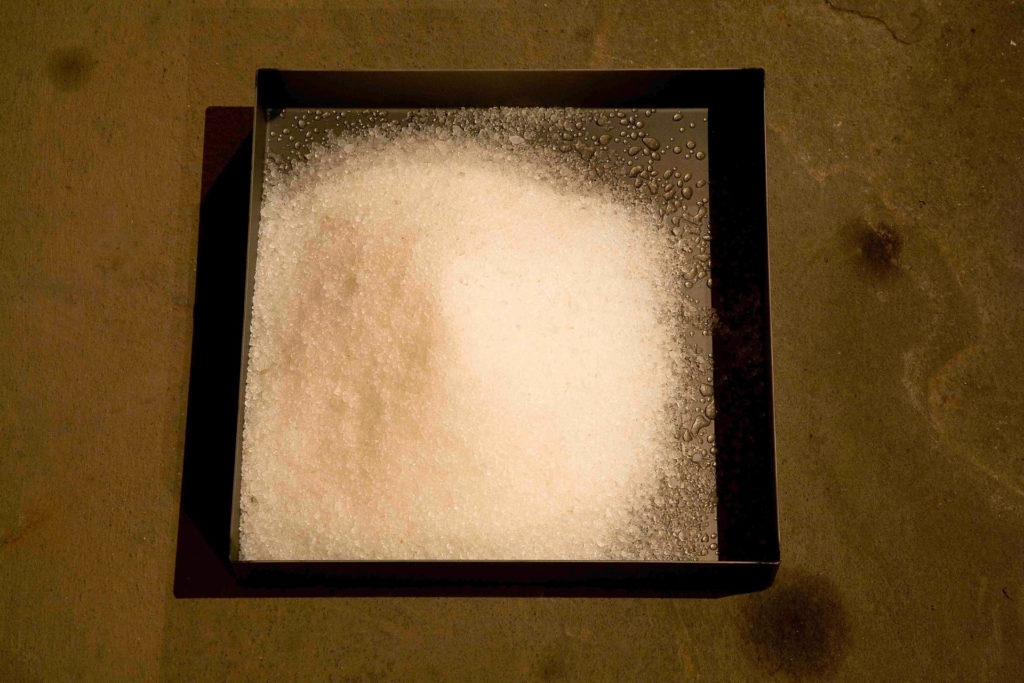LABYRINTHS

The Labyrinth of Chartres Cathedral
»In 1972, I went from San Francisco to Europe and confronted the great pavement labyrinth at Chartres Cathedral. This labyrinth was a reveleation to me in many ways. I had undergone cycles of health, sickness, health, sickness, with attendant hospitalization, release, hospitalization realease, for 11 years. The labyrint at Chartres has 11 concentric rings, which seemd to correspond to these 11 years. The 34 turns leading into the center of the labyrinth also corresponded to these cycles. I had just gont through a major operation that finished once and for all these cycles and seemed to have reached the center of the labyrinth. My energies up to this point had been involved in reaching this center and I decided to reverse this process and work my way out by basing all my future work on the labyrinth of Chartres.
The labyrinth is made of blue and white paving stones set into the stone floor of the cathedral. It is a unicursal path winding in 34 turns through 11 concentric rings to the center. It is 12.87 metres in diameter and has 552 steps following ist course from the entrance to the center. Although it exists physically on the floor of the cathedral, it is not really an object at all: it is a metaphor.«
Excerpt: "Terry Fox – Ocular Langaur", Gesellschaft für Aktuelle Kunst, Bremen, 2000, p. 119
Action for a Tower Room
1972
action / situation with sound
duration: three days, six hours a day
place: tower room in Fridericianum, Kassel
elements: Tamboura (Indian 4-stringed droning instrument), a candle, a stone block (with water)
»Action for a Tower Room – my first work after the initial confrontation with the labyrinth of Chartres – was performed at Kassel for documenta 72. I worked In a small, square stone room at the top of a tower reached by winding narrow stairs. The public coul look into the room through an open door, but not enter it. I played a drone instrument, the tamboura, 6 hours a day for 3 days, filling the space with continuous circular sound.
My idea was to discover the particular acoustic qualities of this room and transform it into a resonating chamber like the inside of the tamboura. I tested the reverbarating sound qualities of all the surfaces of the empty room, i.e. the corners, the windows, the walls, etc. During this performance I influenced the movement of a candle flame by the sound vibrations from the strings of the tamboura. In the same way, I created vibrations in still water filled to the toop of a stone block with an inverted pyramid cut into it. I found the stone in the tower.«
Excerpt: "Terry Fox – works with sound", Stadtgalerie Saarbrücken, 1999, p. 62
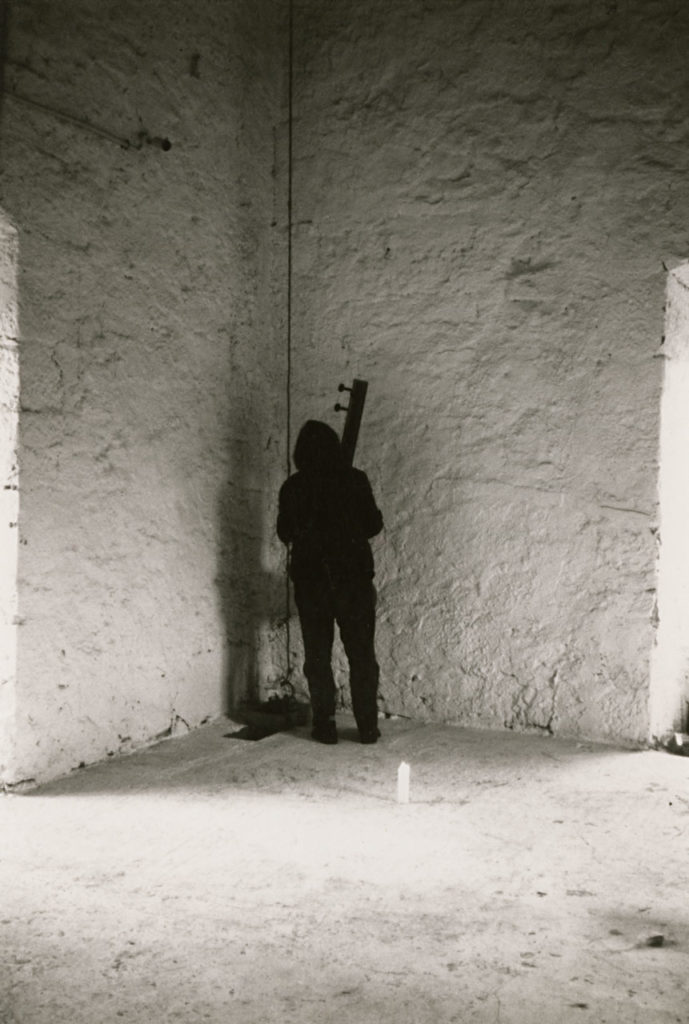
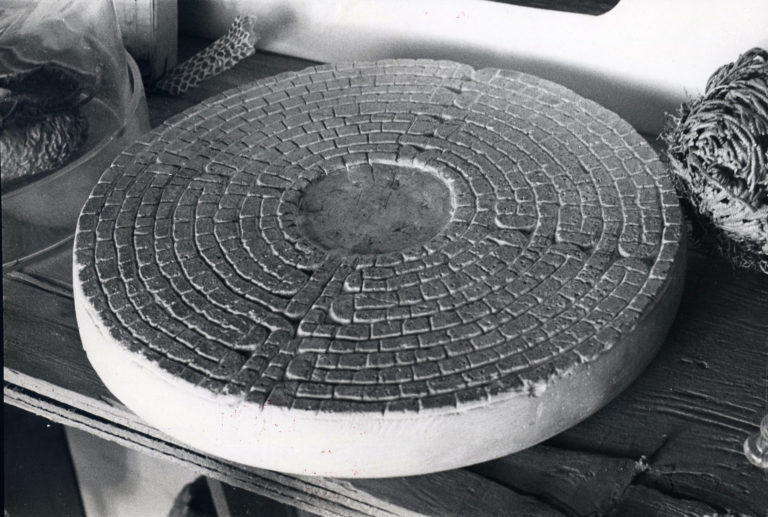
The Labyrinth in Plaster
1972
object
plaster
2,2 x 19,1 cm / 19 cm diameter
location: University of California, Berkeley Art Museum and Pacific Film Archive
»Back in San Francisco, I made a small plaster model of the labyrinth by incising the 552 steps into a plaster disc taken from the bottom of a bucket a friend was using for casting plaster. I made a video tape (Incision) by coverin the lens of a Sony Portapak with a plastic dime store magnifiying glass and following the course of the labyrinth. This 20 minute tape was accompanied by sounds produced by a homemade instrument of piano wires strechted over a metal bowl.«
Excerpt: "Terry Fox – Ocular Langaur", Gesellschaft für Aktuelle Kunst, Bremen, 2000, p. 121
Sketch for A tryptich of crosses
ca. 1972
drawing/collage
27,9 x 21,7 cm
»I also began to experiment with the actual design of the labyrinth. The most interesting discovery I amde was that if the 34 turns into the center were changed into right angles of equal distance and plotted on squared paper, following the direction of movement of the path, the 34 turns (right angles) form one half of a tryptich of interconnecting crosses. If this design is reversed and the two joined together, a perfect and beautiful endless loop of interconnected crosses is formed. I made drawing and small objects of this phenomenon.«
Excerpt: "Terry Fox – Ocular Langaur", Gesellschaft für Aktuelle Kunst, Bremen, 2000, p. 121
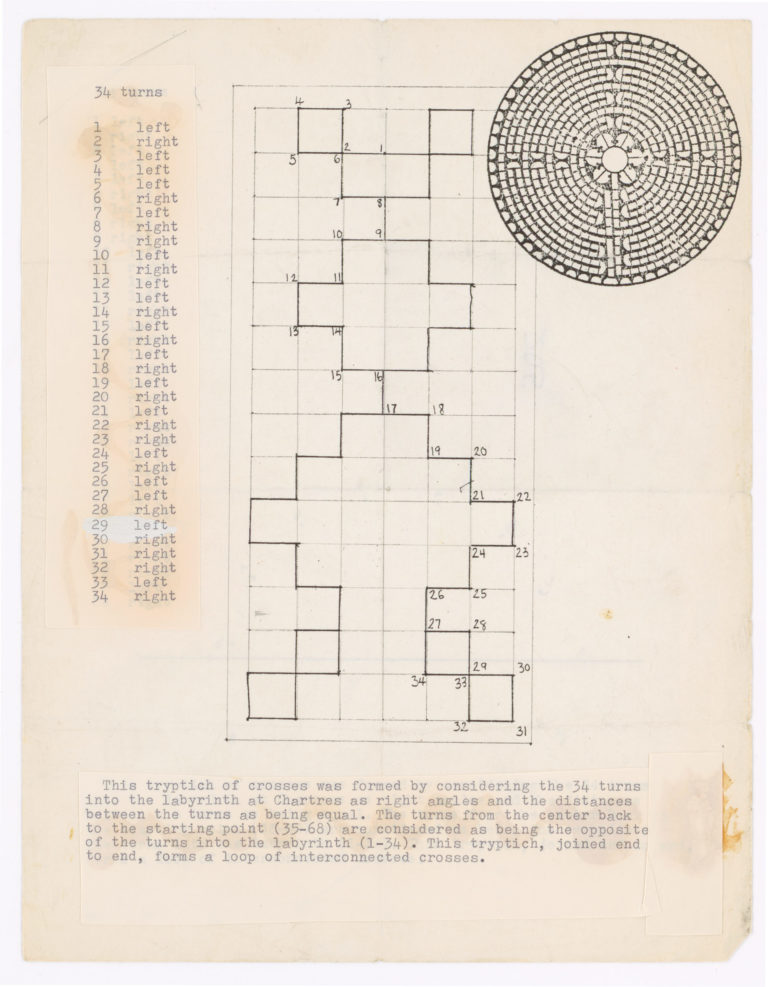
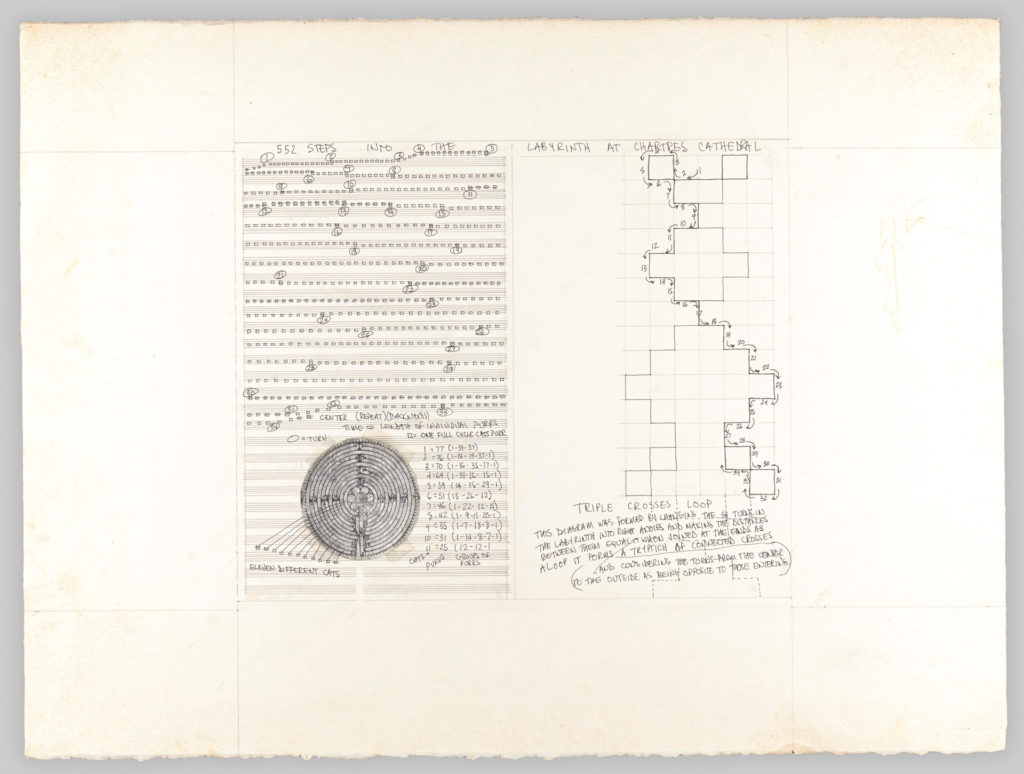
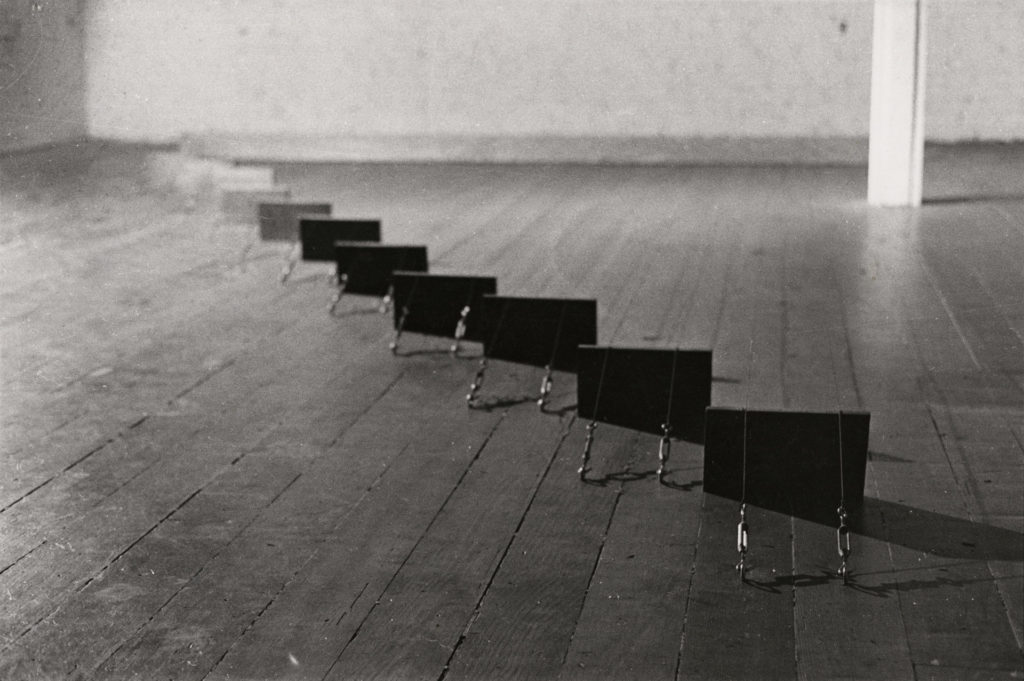
552 Steps Through 11 Pairs of Strings
1976
August 14, 1976, 10 pm
place: artist’s studio, 16 Rose Street, San Francisco, USA
action / performance / situation, with sound
with audience
elements: piano wires (eleven pairs of eleven different thickness and lengths), turnbuckles, wooden bridges, felt-tipped mallets, 34-foot string
»552 Steps Through 11 Pairs of Strings was a performance in my loft in San Francisco in which I stretched 11 pairs of piano wires of 11 different thicknesses across the wooden floor of my studio. These wires were attached to turnbuckles at each and the turnbuckles were hooked to eye-screws screwed into the wooden floor. Each pair of wires passed over a wooden bridge at both ends. The whole took the shape of a giant horizontal harp with the longest pair of wires being 34 feet and the shortest 3 feet. These pairs of wires represent the 11 concentric rings of the Chartres labyrinth, the longest being the outside ring and the shortest representing the innermost ring. I played them with a soft mallet held in one hand and a score in the other. The score was a 34 floor string tied with 552 knots, each now representing an actual step in the labyrinth with the 34 turns indicated by either a piece of wire in a knot (a move to the next longer pair of wires) or a rubber band around a knot (a move to the next shorter pair). This 4 1⁄2 hour performance was done with the audience in the dark loft of the next floor below. The sound moved in waves from their ceiling, which was also my floor. Their room became the sounding box of my instrument.«,
Excerpt: "Terry Fox – Ocular Langaur", Gesellschaft für Aktuelle Kunst, Bremen, 2000, p. 124
The Labyrinth Scored for the Purrs of 11 Different Cats
1976
audio work
90’ stereo
»In 1976 I decided to make a composition for tape. I tried to think how I could do it … using different kinds of instruments? I remember, one of the artist downstairs had a cat and I used to go and visit him and the cat would always sit on my lap, I petted it and it would begin purring, and this deep purring, this in and out purr of a cat which everybody knows, reminded me of stepping and I suddenly got the idea that the steps should be transformed into purrs, into cat purrs and so I decided to make a composition that involved the purring of 11 different cats, one cat each representing one of the 11 rings of the labyrinth.
I put an advertisement in the San Francisco News Paper under want adds and I sad that I needed to record the purrs of cats, that really purred loud and constantly and said that it was for an art project, a musical project. I began to go with my tape recorder to peoples houses to record the purrs of the cats. Each of the 552 steps I changed into 10 seconds, no matter whether the cat purred slow or fast: 10 seconds was one step.
In San Francisco I did Tom, Bugaloo, Puffin, Ernest, Samantha. These were all the good sounding cats I managed to get although I went to 25 different places. Then I heard about Z.B.S. New York, as far as I knew it was run by Bob Bielecki. I wrote them and explained that I was working on this project and that I have to make a mix and make a record or tape there and they agreed that I could come. It was Upstate New York in the country side. I still didn’t have enough cats. They said, thats no problem, we have five cats up here and they all purr like crazy. So in New York I recorded Paddy, Miriam, Furgeson, Spot and Arthur.«
Excerpt: interview for the radio program „Sympathetic Streams – Portrait of the Sound Poet Terry Fox“ by Marita Loosen-Fox, Studio für Akustische Kunst, WDR, Köln, 2003
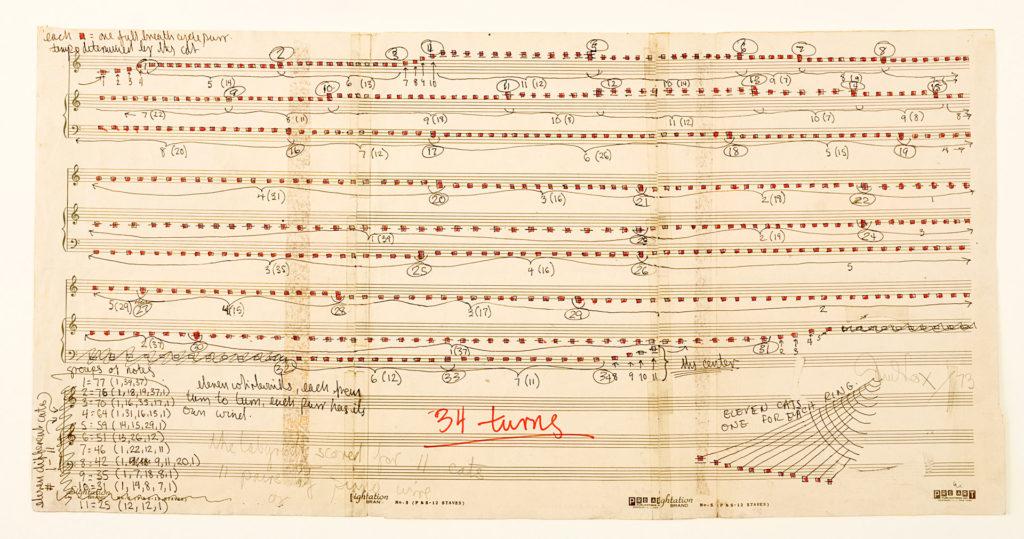
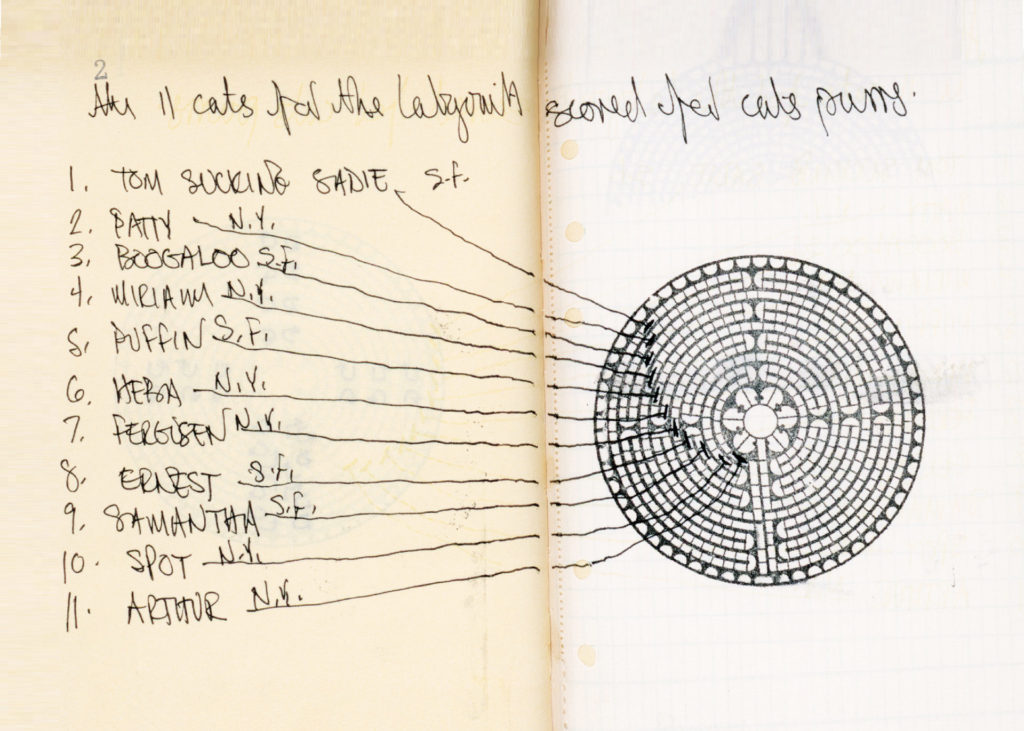
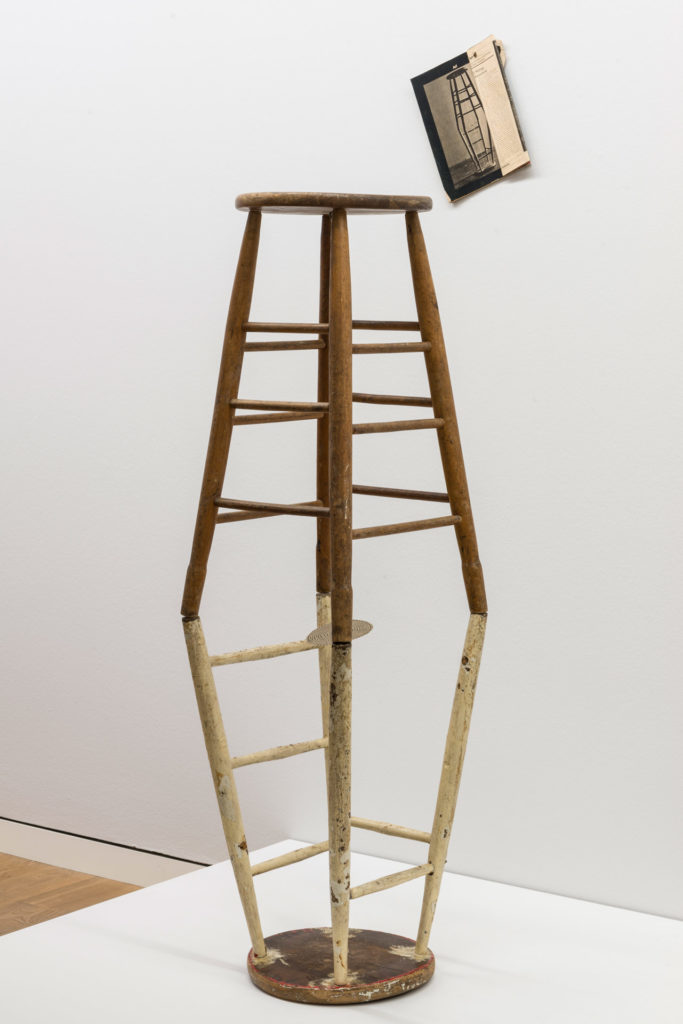
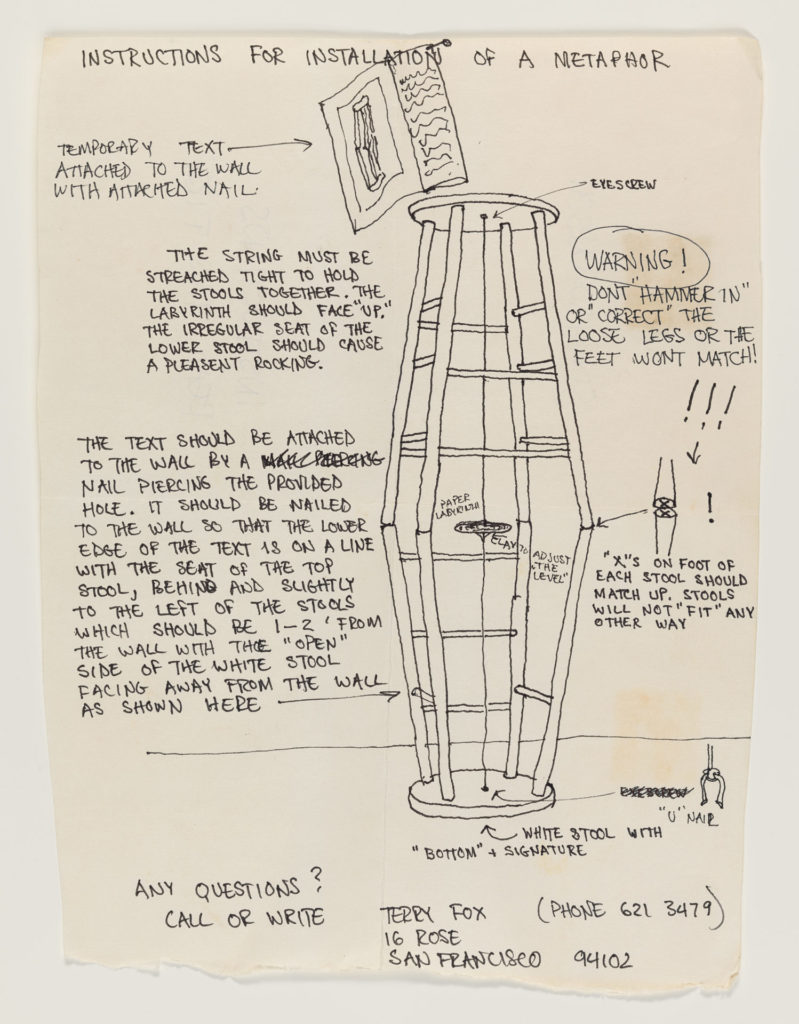
A Metaphor
1976
object
elements: two wooden stools,
magazine text, string, paper, and ink
dimensions:
142.24 cm x 42.55 cm x 40.64 cm
location: Museum of Modern Art, San Francisco
»Representing the cathedral at Chartres, this key piece of Fox’s Labyrinth series is composed of two stools with a paper diagram of the labyrinth suspended between them on a piece of string. Just as this paper labyrinth is equidistantly placed between the round seats of the stools, the labyrinth at the cathedral at Chartres was built precisely at the midpoint of the bottom of the water table (beneath the cathedral) and the top of the cathedral.«
Exhibition text: Terry Fox. Universtity Art Museum, University of California, Berkeley, 1987
Untitled
1978
floor sculpture / in public space
Elements: Labyrinth of Chartres, engraved by a stonemason on a square stone (1 x1 m). Dowser (looked for water flowing underground; the stone was set into the ground at this point).
location: Podio del Mondo per l´Arte, Middelburg, NL
curator: Marinus Boezem
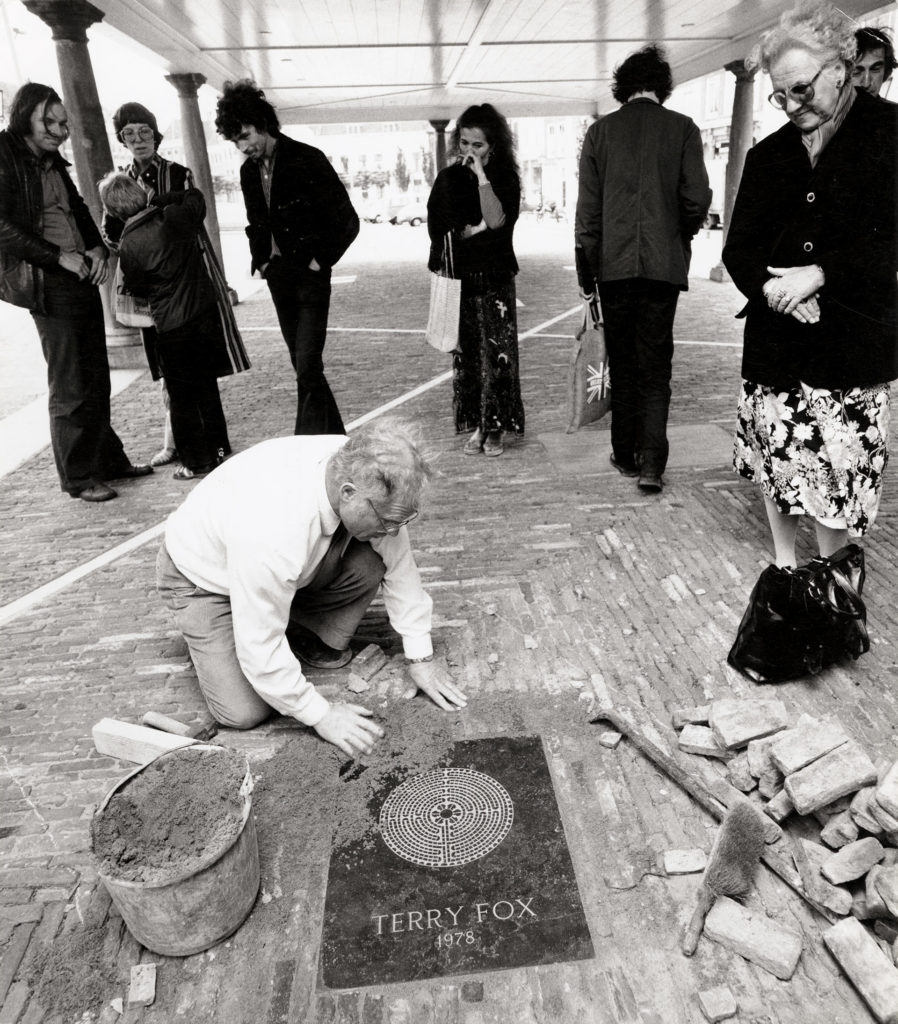
Labyrinth of the Inner Ear
2006
audio installation, stereo
digital, 70 min.
place: former Polish Embassy, Berlin as part of “sonambiente. festival für hören und sehen“, Berlin, 2006
Blindman tapping his metal cane – Siegfried Saerberg
Recording and engineering – Ernst Karel
The Sonic Stroll:
Anhalter Strasse, Stresemannstrasse, Kleiner Seitweg durch Park,
U-Bahn Potsdamer Platz, Holocaust Mahnmal, Brandenburger Tor,
Unter den Linden, Ehemalige Polnische Botschaft
»Labyrinth of the Inner Ear is a kind of ›drone‹ work consisting of the repetitive tapping of a sightless person. Terry Fox’ artist friend Siegfried Saerberg navigated his way through an urban environment of Berlin, accompanied by the sound of his white cane, either tapping or sweeping back and forth. The line of the sonic route resembles a half-arch that follows the curved shape of the human inner ear, from the hearing to the balance area. Finding the way by listening, balancing, the labyrinth as a signpost and the sound that forms space and time – these central motifs in the work of Terry Fox here are, once again, brought together.«
Marita Loosen-Fox, 2021

34 turns
2009
installation, with sound
realisation: Marita Loosen-Fox and Carsten Seiffarth
place: Großer Wasserspeicher Berlin, singuhr hoergalerie / Singuhr e.V., Berlin
elements: 34 metal trays (34 x 34 x 5,5 cm), steel plate, coated with clear varnish,
34 x 3 kg salt crystals (sea salt ), two mikrophones (outdoors), nine loudspeakers
»34 Turns is the final large-scale installation project by artist Terry Fox, who died in October 2008 and whose works, straddling sculpture and sound, gave significant momentum to sound art. With 34 Turns, Fox developed an installation that links the water reservoir’s mazelike, vaulted architecture to the famous labyrinth at Chartres Cathedral, with its 34 turns. Simple metal trays, containing salt crystals, are installed in the 34 individual chambers of the reservoir’s outer ring. Imperceptibly slowly, the crystals bind the humidity that is released into the air. This transformation process ›at the threshold of audibility‹ is accompanied by the very discernable sounds and noises that are carried from the urban surroundings into the interior chamber at the centre of the reservoir and that then unfurl from the middle of the vault as a fine acoustic wave in the space. 34 Turns is the expression of a slow and poetic convergence on a space and its associative potential.«
Exhibition flyer, singuhr hoergalerie, 2009
